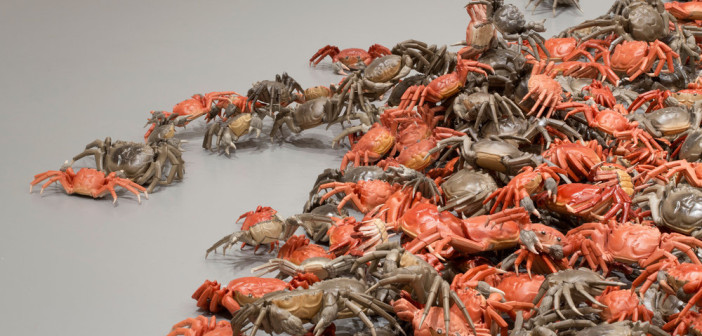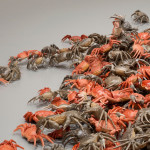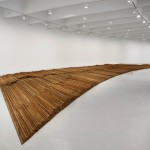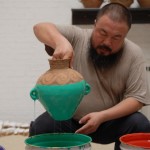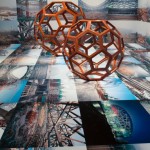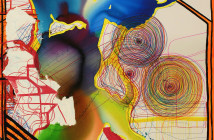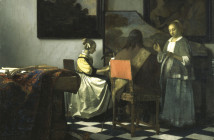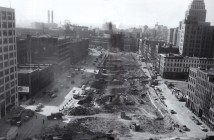October 12, 2012
Recognized by ArtReview as the art world’s "Most Powerful Figure" in 2011, Ai Weiwei is no stranger to the art world. Best-known for his collaboration with Herzog & de Meuron on the design of the Beijing Olympic Stadium, his ubiquitous presence in social media and detention for political and social activism, Ai Weiwei is China’s most provocative contemporary artist. It comes as no surprise then that his first North American survey is at Hirshhorn Museum and Sculpture Park in Washington, D.C. The retrospective—which opened on October 7th—is a revised and updated version of the exhibition originally shown in 2009 at the Mori Art Museum in Tokyo featuring over 35 artworks, including two new never before seen and has prompted a discourse about political and social change through art.
Opening the exhibition is wall text featuring a quote by the artist himself. "This so-called contemporary art is not a form, but a philosophy of society," says Ai Weiwei of his art, both communicating the show’s intention and challenging the viewers "to approach it as contextual art in the most general sense, rather than solely as conceptual art." In positioning his activism as the leading premise of his work and not detaching it from his role as an artist, the curator, Mami Kataoka, has produced a show that well-suits the political climate of D.C.
The theme of old vs. new in Ai Weiwei’s art is present throughout. The exhibition begins with photographs of the Beijing Olympic Stadium’s construction, pasted on the walls and floor of the gallery. In a corner of this gallery are two hollowed-out icosahedrons made from traditional Chinese wood. Down the hall, photographs of demolished buildings in fast-developing Chinese cities are paired with large bowls of freshwater pearls. The relationship between these harsh, high-definition photos of construction and destruction and these ultimate representations of Chinese culture embodies the spirit of China today. The old is discarded and replaced with the new while culture and history is too easily forgotten. The most iconic artwork critiquing this problem in Chinese contemporary society is Colored Vases, where Ai took Han dynasty vases and dipped them in industrial paint. The act of concealing the traditional ornamentation of these antique Han vases provokes the question of authenticity and value of the artwork and Chinese culture and history in general.
Colossal wooden sculptures, such as Map of China and Moon Chest, occupy much of the main exhibition hall and are not only made from Chinese wood, but were also assembled through traditional joinery techniques. This presents Ai Weiwei’s turn to old methods to create something new and original. Ai Weiwei also took pieces of furniture from the Qing dynasty, disassembled and reconstructed them into a state that alters the object’s meaning and obscures its function. By making the useful no longer functional, Ai has distorted the viewer’s basic perception of the object and the space it occupies.
A long wall covered with the names of 5,200 schoolchildren who died during the 2008 Sichuan Earthquake stands out among the other work. Compelling in magnitude and significance, the piece was conceived through Ai’s investigation of the higher death toll of schoolchildren during the earthquake. The higher death toll was due to tofu construction, a term in China referring to poorly constructed buildings. Ai Weiwei was subsequently reprimanded for his actions by the Chinese government, with police swarming his hotel room in the middle of the night to beat him up. A year later, he posted a call on the Internet for volunteers to read and record the names of these children. Over 100,000 Chinese netizens responded to the call, and their haunting voices can be heard and experienced as the visitor is confronted with the staggering magnitude and implication of these names.
HeXie and Wenchuan Steel Rebar are the two new works. HeXie is a collection of 3,200 true-to-life porcelain crab figures. It plays on the word "hexie", which literally means "river crab", but is also the homophone for "harmonious society," a slogan used by the Chinese Communist party that has been reinterpreted by the Internet as "censorship". In 2010, immediately after the Shanghai government invited Ai Weiwei to establish a studio; it was soon after demolished by the authorities. In response, Ai invited guests through Twitter to join him in a feast of river crabs. The artwork, Hexie, simultaneously refers to this particular event in the artist’s life while protesting government censorship and control of information and reflecting on the notion of artificiality and authenticity.
Adjacent to this artwork is Wenchuan Steel Rebar, in which the artist arranged salvaged rebar from the rubble of collapsed schools in Sichuan into a large-scale Minimalist landscape. Confronted with the enormous mass of the rusty steel rebar on the ground, I was at first unaware of its significance. However, closer observation revealed a definite partition in the middle; and instantly, I was faced with the reality of the work. The partition evoked in my mind an earthquake crevice and at once, transported me to that spot. Although, I knew that I was just looking at an artwork in a gallery, I could not shake the feeling that the ground beneath my feet at any moment would split and I would be just like the victims of the 2008 Sichuan Earthquake, too fast gone and forgotten.
Upon leaving the exhibition, it was evident to me that Ai Weiwei’s life is not detached from his art. Several of Ai Weiwei’s quotes, much like the one at the exhibition’s entrance, are dispersed throughout the exhibition. These quotes not only inject truth to the works that surround them, but also give insight to the artist’s personal convictions.
Additionally, the second floor of the exhibition includes 12 screens, each screen playing a slideshow of photographs taken by Ai Weiwei and his Beijing FAKE studio. Organized into slideshows of animals, bizarre haircuts and Ai cutting hair, food, travels, self-portraits, and special events, the selection of highly personal, casual, and at times incredibly humorous snapshots of Ai Weiwei’s life made me feel as if I was scanning his Facebook photo albums or Instagram feed. The copious number of photographs provided by the artist and his studio reveals the inseparable nature of his life and art, and guide the viewer towards understanding that Ai Weiwei’s life truly is his art.
- He Xie (detail) Ai Weiwei, He Xie (detail), 2010— Installation view at the Hirshhorn Museum and Sculpture Garden, Washington, DC, 2012. Photo: Cathy Carver
- From top to bottom: Dropping a Han Dynasty Urn, 1995/2009; Colored Vases, 2007-2010. Installation view of Ai Weiwei: According to What? at the Hirshhorn Museum and Sculpture Garden, Washington D.C., 2012. Photo: Cathy Carver
- Ai Weiwei, Straight, 2008—12 Installation view at the Hirshhorn Museum and Sculpture Garden, Washington, DC, 2012. Photo: Cathy Carver
- Ai Weiwei, Colored Vases, 2007-2010. Image courtesy of the artist.
- From left to right: Beijing’s 2008 Olympic Stadium, 2005-08; Divina Proportione, 2006; F-Size, 2011. Installation view of Ai Weiwei: According to What? at the Hirshhorn Museum and Sculpture Garden, Washington D.C., 2012. Photo: Cathy Carver
Hirshhorn Museum and Sculpture Garden
"Ai Weiwei: According to What?" is on view October 7, 2012 - February 24, 2013 at Hirshhorn Museum and Sculpture Garden in Washington, DC.
All images are courtesy of the artist and the Hirshhorn Museum and Sculpture Garden.

